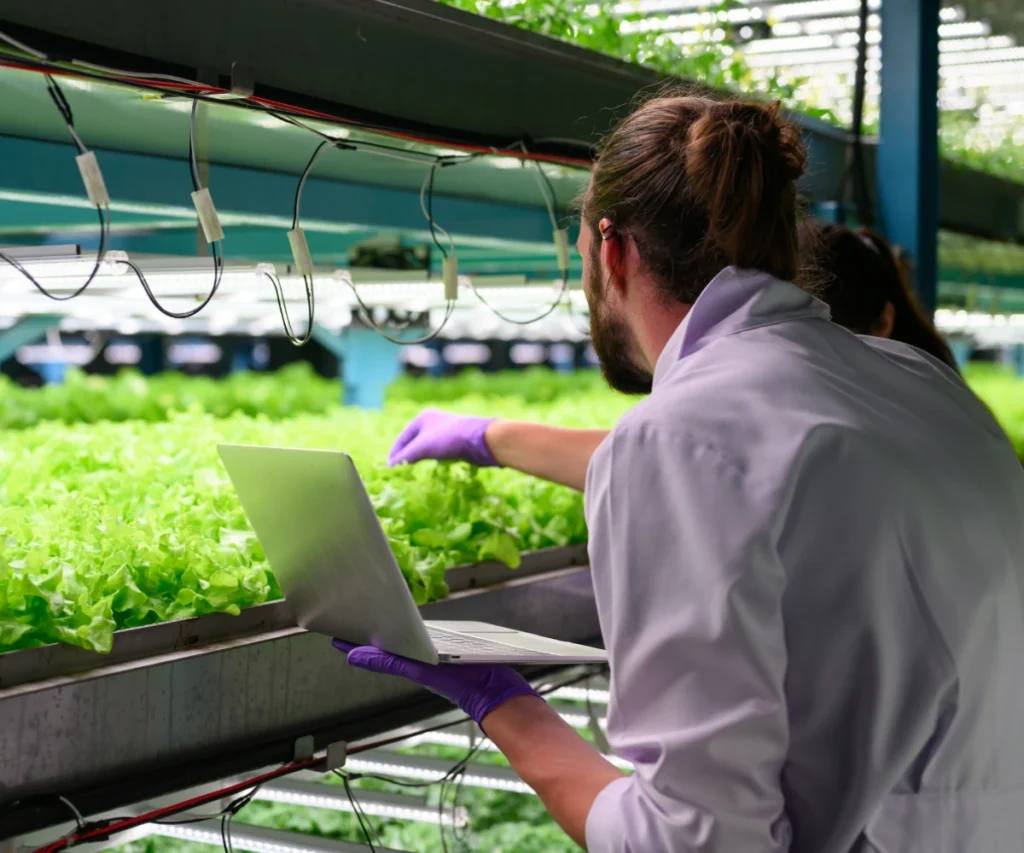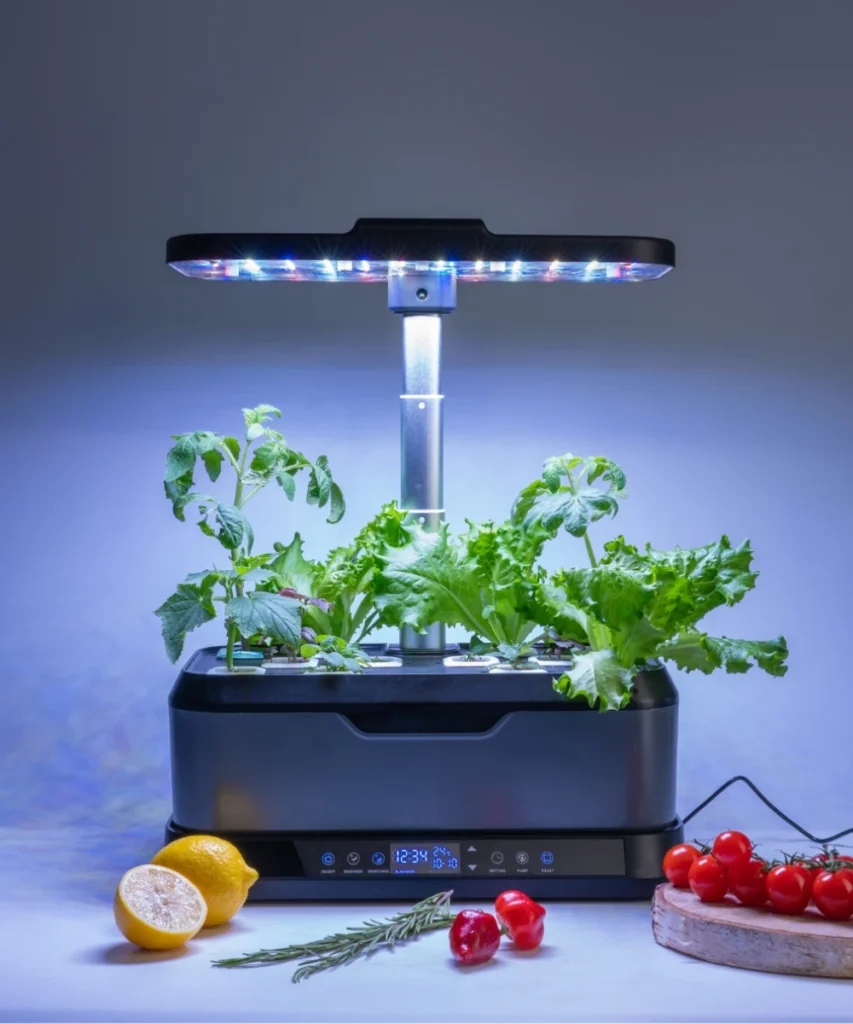Revolutionizing Home Gardening with Automation
Automated vertical gardens are redefining the way we grow plants at home, blending cutting-edge technology with innovative design. These smart systems take care of crucial tasks like irrigation, lighting, and nutrient delivery, enabling anyone to create a thriving green space, even in the busiest schedules or smallest homes.
Imagine turning an empty wall or a tiny corner of your living space into a vibrant, productive garden with minimal effort. That’s the magic of automated vertical gardens.
But what are these systems exactly, and how do they operate? Let’s explore them in detail to see how they’re revolutionizing contemporary gardening practices.
Prefer a visual approach? Watch the video for more details.
What Are Automated Vertical Gardens?
At their core, automated vertical gardens are smart gardening solutions that combine vertical growing structures with automation technology to simplify the cultivation process. Designed to maximize efficiency and minimize manual effort, these systems are perfect for urban dwellers or anyone looking to bring greenery into small spaces. Here’s how they work:
- Irrigation: Precise self-watering systems deliver just the right amount of water directly to plant roots, reducing waste and ensuring hydration.
- Lighting: LED grow lights mimic natural sunlight, allowing plants to thrive indoors or in areas with limited light.
- Nutrient Delivery: Automated dispensers provide plants with the perfect blend of nutrients at the right times.
- Monitoring: Sensors track soil moisture, temperature, and light levels, making adjustments to maintain optimal growing conditions.
By automating these processes, vertical gardens become accessible to everyone no green thumb required!
Smart Technology in Vertical Gardens: Innovations for Modern Cultivation

Smart technologies are revolutionizing vertical gardens, making them more efficient, customizable, and sustainable. Here’s how these innovations are reshaping plant cultivation in small spaces:
IoT Applications for Plant Management and Monitoring
IoT technologies enable the creation of intelligent systems that remotely monitor and control vertical gardens. Connected sensors collect real-time data on soil moisture, air quality, temperature, and light levels.
This data is sent to the cloud, where it can be analyzed and accessed via mobile devices or computers. Additionally, automated systems can adjust irrigation, activate grow lights, or ventilate the environment, ensuring optimal conditions for plant growth.
Smartphone Apps for Remote Vertical Garden Management
Dedicated apps are transforming the gardening experience. With user-friendly interfaces, these apps allow users to adjust garden parameters, receive alerts about environmental changes, and access personalized recommendations for various plant species.
Some apps integrate with virtual assistants like Alexa or Google Assistant, enabling voice control. Moreover, features such as historical tracking and predictive analytics help gardeners anticipate issues and improve plant health.
Artificial Intelligence (AI) and Machine Learning for Optimized Plant Growth
Advancements in AI and machine learning have introduced sophisticated algorithms for managing vertical gardens. These algorithms analyze large datasets, identify patterns, and make automated decisions to optimize critical factors, such as:
- Lighting: Dynamic adjustments to light intensity and spectrum based on each plant’s needs and growth cycle.
- Temperature: Automated microclimate control through heating or cooling systems.
- Nutrients: Precise dosing of fertilizers based on soil conditions or hydroponic solutions.
AI systems can also predict the impact of environmental changes and recommend efficient cultivation strategies, such as plant rotation or introducing new species better suited to the available space.
Integration with Sustainable Energy Systems
The incorporation of solar panels and rainwater harvesting systems with smart technologies is another significant advancement. These integrations make vertical gardens more self-sufficient and eco-friendly, reducing environmental impact and operational costs.
Augmented Reality (AR) in Vertical Gardening
As an added layer of technology, augmented reality applications assist users in planning their vertical gardens. With AR, gardeners can simulate plant layouts, position virtual grow lights, and visualize how different species would adapt to the space before planting begins.
These advanced technologies are turning vertical gardens into more than just practical and aesthetic solutions they represent the future of modern gardening, blending innovation and sustainability to meet the demands of urban living and contemporary lifestyles.
Advancing in Vertical Farming
Take your food production to the next level with automated vertical farming systems. These technologies combine IoT and AI to optimize large-scale commercial farming, offering efficient and sustainable solutions for growing fresh, healthy produce.
Learn More
Discover cutting-edge systems for commercial vertical farming here.
The Benefits of Automated Vertical Gardens
- Convenience
Smart systems take over daily gardening tasks, like watering and feeding, freeing up your time while ensuring plants are well cared for. - Efficiency
Advanced technology optimizes resource use. Automated systems save water, energy, and nutrients by delivering exactly what plants need. - Consistency
Gardening success often relies on regular care. Automation ensures plants receive consistent attention, fostering healthier growth. - Space Optimization
Vertical designs are perfect for small apartments, balconies, or urban homes, allowing you to grow more in less space. - Accessibility
Whether you’re new to gardening or a seasoned expert, automated vertical gardens make it easy for anyone to cultivate plants successfully.
Key Components of an Automated Vertical Garden
To understand how these systems work, let’s break them down into their essential components:
1. Smart Irrigation Systems
Efficient watering is key to a healthy garden, and automated irrigation ensures plants receive the perfect amount of water.
- Drip Irrigation: Targets the roots directly, preventing overwatering or evaporation.
- Self-Watering Planters: Built-in reservoirs keep plants hydrated for days.
- Sensors and Timers: Automatically adjust watering schedules based on soil moisture levels.
2. LED Grow Lights
Light is crucial for photosynthesis, especially in indoor gardens.
- Full-Spectrum LEDs: Simulate sunlight, making it possible to grow plants in dimly lit spaces.
- Adjustable Timers: Control the duration of light exposure to suit different growth stages.
- Energy Efficiency: LEDs provide optimal lighting with minimal energy consumption.
3. Nutrient Dispensers
Plants require a balanced diet of nutrients, and automated systems make this effortless.
- Automated Feeding: Supplies the right nutrient mix at the right time.
- Ease of Use: Liquid fertilizer reservoirs are easy to refill and maintain.
4. Monitoring Sensors
Keep your garden thriving with real-time data on environmental conditions.
- Soil Moisture Sensors: Ensure hydration levels are just right.
- Temperature and Humidity Monitors: Maintain optimal growing conditions.
- Light Sensors: Adjust brightness to match plant needs.
5. Mobile App Integration
Control your garden from anywhere using a smartphone or tablet.
- Real-Time Monitoring: Check on your plants’ health and system performance.
- Notifications: Receive alerts for low water levels or maintenance reminders.
- Growth Insights: Track progress and make data-driven adjustments.
Setting Up an Automated Vertical Garden
1. Choose the Right System
Select a setup that matches your space and goals:
- Modular Systems: Adaptable and ideal for compact areas.
- Wall-Mounted Units: Great for herbs, greens, or ornamental plants.
- Freestanding Towers: Perfect for larger gardens with diverse plants.
2. Pick the Best Plants for Automation
Choose plants that thrive in vertical setups and automated environments:
- Herbs: Basil, parsley, mint.
- Leafy Greens: Lettuce, spinach, kale.
- Compact Vegetables: Cherry tomatoes, peppers.
- Ornamentals: Snake plants, ferns, pathos.
3. Assemble Your System
Follow these steps to get started:
- Install the vertical frame and secure planters or growing slots.
- Link the irrigation system to a water supply.
- Attach sensors, lights, and nutrient reservoirs as per instructions.
4. Program and Customize
Use the app or control panel to set up schedules for watering, lighting, and feeding. Adjust settings based on the specific needs of your plants.
Maintenance Tips for Automated Vertical Gardens
Even automated systems need occasional upkeep to function optimally:
- Inspect Systems: Regularly check irrigation lines, reservoirs, and sensors for clogs or damage.
- Clean Components: Wipe down lights, planters, and sensors to prevent buildup.
- Prune Plants: Trim overgrown leaves to maintain airflow and aesthetics.
- Update Software: Ensure apps and devices are up to date for optimal performance.
Creative Applications of Automated Vertical Gardens
- Kitchen Herb Wall
Grow fresh, ready-to-use herbs like basil and parsley right in your kitchen. - Living Green Walls
Transform blank walls into vibrant, air-purifying vertical gardens. - Educational Spaces
Teach children or communities about sustainable gardening through hands-on experiences. - Workspaces
Enhance productivity and reduce stress by adding greenery to home offices or workspaces.
Challenges in Smart Vertical Gardens

Implementing smart vertical gardens involves significant upfront costs for advanced technologies like IoT sensors and automated systems, as well as increased energy consumption, which raises environmental and financial concerns.
Additionally, the reliance on artificial lighting has sparked debates about its impact on natural plant growth cycles.
While technological advancements aim to address these issues with more affordable and energy-efficient solutions, achieving a balance between innovation and practicality remains crucial for widespread adoption.
Why Automated Vertical Gardens Are the Future
- Sustainability: These systems reduce water and resource waste, making them eco-friendly.
- Urban Adaptability: Ideal for city living, they allow gardening in spaces that would otherwise be unusable.
- Innovation: By integrating technology with gardening, these solutions offer a modern approach to cultivating nature indoors.
If you want to learn more about how this technology is transforming home cultivation, check out our article on Smart Vertical Gardens: The Future of Home Growing.
Conclusion: A Smarter Way to Garden
Automated vertical gardens blend technology with nature, making gardening more accessible, efficient, and rewarding than ever before. Whether you’re a seasoned plant lover or just starting your green journey, these systems empower you to cultivate lush greenery effortlessly.
Imagine waking up to fresh herbs, vibrant vegetables, or a stunning living wall in your home all with minimal effort on your part.
Start your automated gardening journey today and transform your living space into a green sanctuary.
With just a little setup and the magic of automation, you can create a sustainable, beautiful, and thriving indoor garden that fits perfectly into your modern lifestyle.

